It’s arguable that innovative car design across the 20th and 21st centuries has shaped every single human’s view of the world - and likely more so than any other industry.
From the moment we leave our house to arriving back home, our perception of the world we live in is constantly challenged by every car contour, outline and silhouette we see on our roads. They deeply affect our feelings and our emotions, our happiness and sadness, our essential state of being.
Before any car appears on our roads, they are simply an idea, a drawing, a blueprint – crafted by geniuses with unbelievable foresight and vision regarding what people want to own and drive.
However, while the car designs endure, the people behind these designs are often left forgotten. Far from household names, the designers are simply victims of the success of the cars, with overall credit of their spectacular designs mostly going to the make behind the car in question.
In a series of three in-depth articles we set out to challenge this very assumption, bringing car designers and their influence back to a place where they belong:
1. The greatest car designers of all time: In the first article we bring some key designers back into the limelight, paying homage to nine incredible humans who have been at the forefront of car design over the past 50 years
2. How iconic cars and their creators define a generation: In the second article we assess the cultural impact of cars in a broader context, looking at how often some of the most popular cars are seen and influence people every day, compared to other iconic forms of architecture, design and artistry
3. The car designers who will shape the future: In the last article we outline the top 50 motoring brands in the world and where their current lead designers originate from, simply highlighting how geo-diverse designers are in 2019
The outcome of these articles is fascinating and reshapes not only our view of the impact that cars have on our psyche, but also gives due credit to the amazing people behind these art creations and the places they come from.
1. The Greatest Car Designers of all Time
From pininfarina to the new Jaguar I-Pace, below we pay homage to nine incredible humans who have been at the forefront of car design over the past 50 years:
- 'The Godfather of Modern Car Design’: Battista Farina
- ‘Back to the Future of Design’: Giorgetto Giugiaro
- ‘The Master of Italian Wedge’: Marcello Gandini
- ‘A Style For All Occasions’: Walter De Silva
- ‘The Polariser’: Chris Bangle
- ‘Karma Chameleon’: Henrik Fisker
- ‘From Long Bonnet to Short Bonnet’: Ian Callum
- ‘Inspiration is Everywhere’: Frank Stephenson
- 'The Revival of Nissan’: Shiro ‘Fingers’ Nakamura
‘The Godfather of Modern Car Design’: Battista Farina
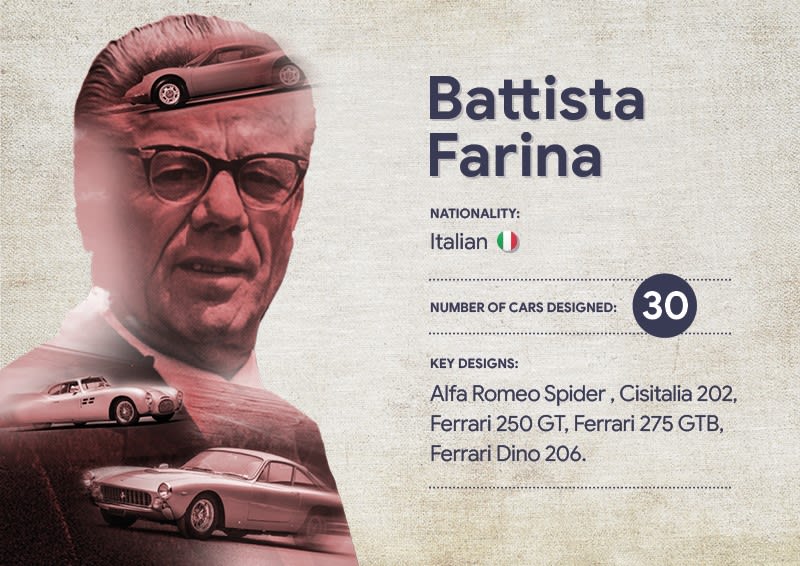
Born in Coranze, Italy, Battista Farina was given the nickname of “Pinin” in his early years, meaning youngest or smallest brother. This nickname would stick with him throughout his motoring career, evident when he formed Carrozzeria Pinin Farina in 1930, a car design and coachbuilder company. The company, headed by Farina, quickly became renowned for their distinct take on automotive design. It was his close relationship with Enzo Ferrari that can account for the many Farina inspired Ferrari’s of the time, such as the Ferrari Dino 206 GT and Ferrari 275 GTB. Along with Ferrari, Farina would go on to work with Rolls Royce, Lancia, Peugeot and Alfa Romeo. With which he would create some of his most distinctive and iconic designs such as the Alfa Romeo Spider, Peugeot 403 and Lancia Aurelia B24 Spyder.
‘Back to the Future of Design’: Giorgetto Giugiaro 
Giorgetto Giugiaro is one of the most influential car designers of his generation and was recognised as such when he was awarded the prestigious title of “Car Designer of The Century” in 1999 and shortly after was inducted into the prestigious Automotive Hall of Fame in 2002.
He’s primarily responsible for classic designs such as the Fiat Punto, Maserati Quattroporte, Seat Ibiza, Volkswagen Golf and the Lotus Esprit. One of his most famous, yet commercially unsuccessful, designs was that of the DMC DeLorean which featured as the mode of transport for Emmett “Doc” Brown in the Back to The Future movie franchise. One of the key figures that inspired the “folded paper” era of the 1970s, which focused on flat surfaces and razor-sharp edges on designs and is still prevalent today.
‘The Master of Italian Wedge’: Marcello Gandini
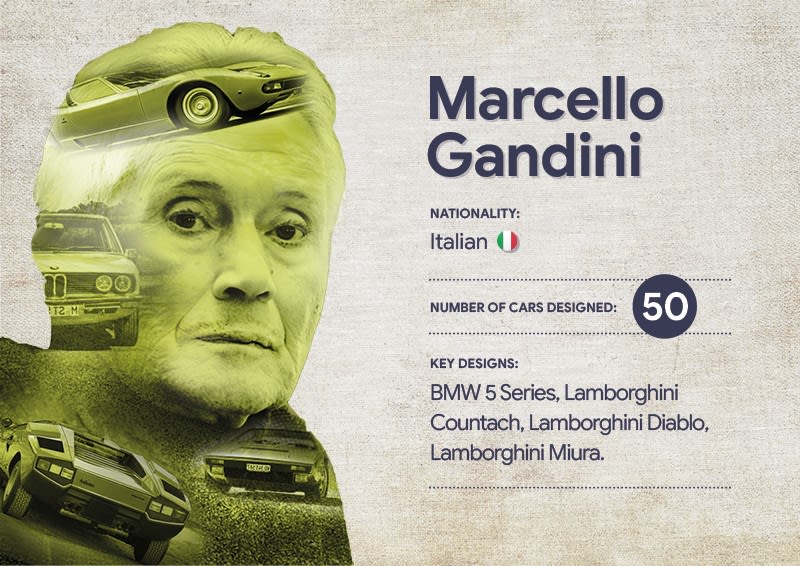
The son of an orchestra conductor, Marcello Gandini was born in Turin in 1938. He made his name by producing ground-breaking designs for Lamborghini in the 1960s and ’70s, including the mid-engined Miura and the more extreme Countach. He famously championed the 'wedge' sports car shape on the Alfa Romeo Carabo, which revolutionized sports car design at the time. However, it wasn’t only when designing supercars that Gandini excelled. Throughout his career he was also heavily influential in creating more practical, everyday vehicles including the BMW 5 Series (E12), Fiat 132, Lancia Sibilo and the Renault 5 “Supercinq”. He worked for styling house Gruppo Bertone, where his path crossed with another of our designers Giorgeto Giugiaro. After leaving Bertone in 1980, Gandini branched out into other areas of design including architecture, industrial and interior.
‘A Style For All Occasions’: Walter De Silva
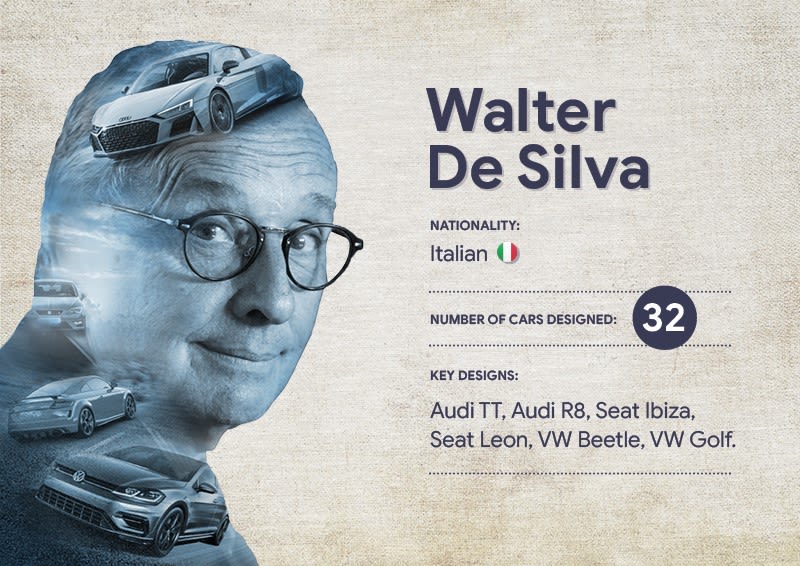
The most prolific designer in our list, responsible for around 32 individual cars, Walter de Silva was known for designing some of the most iconic and best-selling cars of the last 50 years. He began his career at Fiat in 1972 at the age of 21, before moving to the IDEA Institute, an automotive design and engineering company in Turin. After a short stint at Alfa Romeo, he would go on to join the Volkswagen in 1998, as the chief of Seat’s design centre. It was due to his successful tenure in this role, with his designs including the Seat Ibiza and Leon that he would go on to work for several other Volkswagen Group brands such as Audi, Lamborghini, Bentley, Bugatti, Skoda and Volkswagen.
‘The Polariser’: Chris Bangle
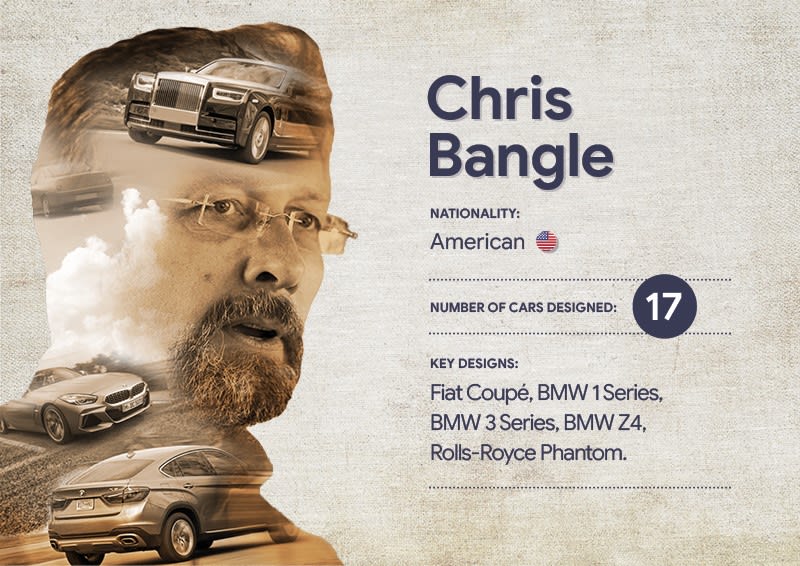
The former chief of design at BMW, Chris Bangle’s responsibilities stretched across the BMW, Mini and Rolls-Royce brands. His designs have had a polarising effect in the automotive community, facing either scathing criticism or admiration for his work. He started his career at Opel working on the Opel Junior concept car before joining Fiat in 1985. It was here that he began to make a real impact, contributing to the second-generation Fiat Panda and working as the chief designer on the Fiat Coupe and Alfa Romeo 145. In 1992, he became the first American to become BMW’s chief of design, where his design influence can be seen throughout the entire BMW line-up, including the BMW 1 Series, 3 Series, 5 Series and 7 Series to name a few.
‘Karma Chameleon': Henrik Fisker
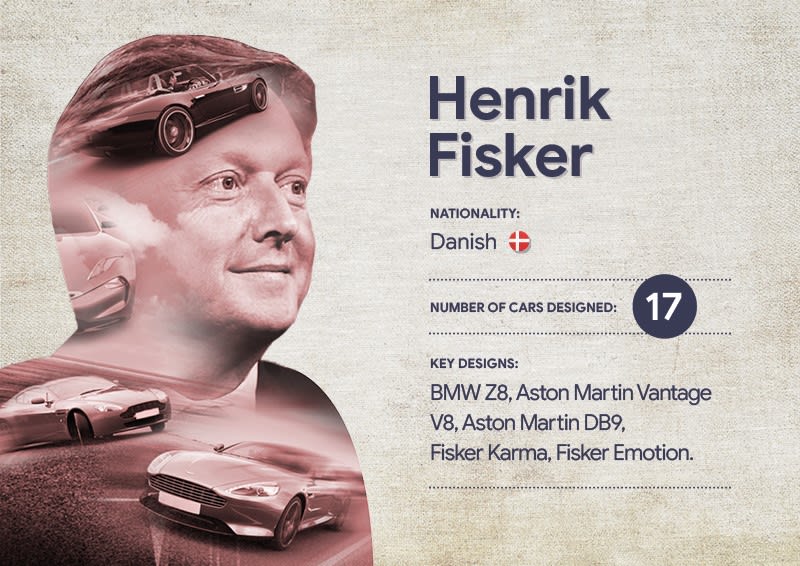
Known for trying his hand at anything, Henrik Fisker is one of the most interesting designers on our list; with an array of unique vehicles attached to his name. Fisker is renowned for designing the world’s first premium plug-in hybrid with the Fisker Karma. The Dane has also made a name for himself by designing iconic luxury cars such as the Aston Martin DB9 and BMW Z8. Beginning his career at BMW before joining Aston Martin as the company’s Design Director, Fisker was responsible for the best-selling Aston Martin of all time, the Aston Martin Vantage After leaving Aston Martin in 2005, Fisker collaborated with several companies in the automotive, lifestyle and nautical sectors before launching Fisker Inc, an automaker that specialises in building innovative electric vehicles. The company is currently developing the Emotion, an all eclectic saloon car with a 400-mile range. No easy feat, but if there is one man who can do it, you would suspect it to be Fisker.
‘From Long Bonnet to Short Bonnet’: Ian Callum
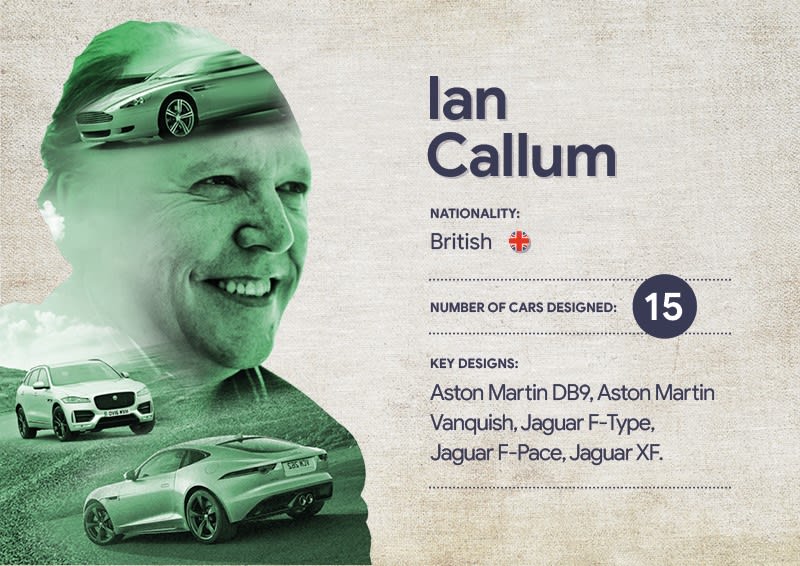
British car designer Ian Callum is the UKs sole representative on the list and is responsible for innovative cars such as the iconic Aston Martin DB7, Aston Martin Vanquish and Jaguar F-Type. He began his career at Ford before forming TWR Design with fellow designer Peter Stevens and racing car driver Tom Walkinshaw. He once said of moving to TWR Design “Some of my colleagues came to see me from Ford, and I’d walked away from this giant studio at Dunton, the corporation, all that stuff, into this little tin shed in Kidlington. They thought I was utterly mad. But I was as happy as could be, I was doing something I wanted to do”. In 1999, he moved to Jaguar where he now serves as Director of Design. Callum featured at the centre of the hit documentary "Jaguar: Going Electric" which gave an access-all-areas account of the launch of the all-electric Jaguar I-Pace. Most notably for Callum, it showed his impact on the groundbreaking deviation from the long bonnet's of Jaguar cars of the past, to the short-bonnet design more keenly adapted for the electric future.
‘Inspiration is Everywhere’: Frank Stephenson 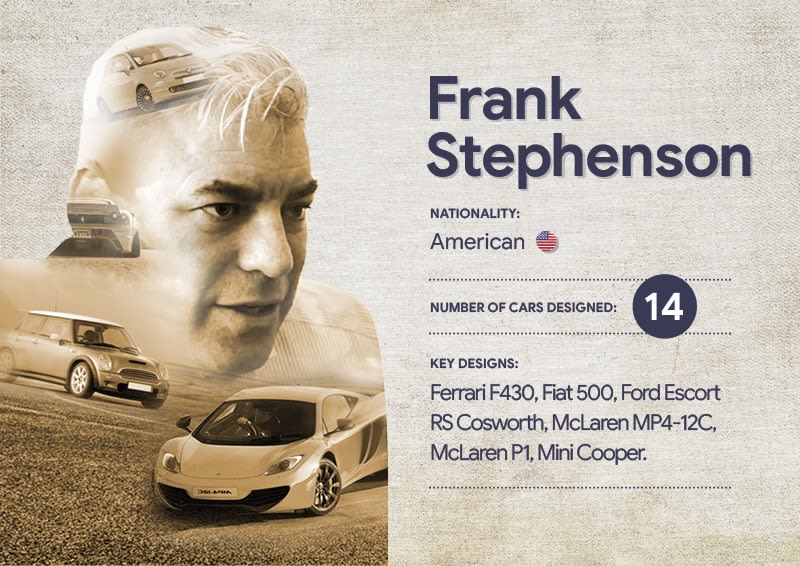
Known for his landmark work for Fiat, Mini, Alfa Romeo and McLaren, Frank Stephenson is responsible for several of the most iconic car designs of recent times including the Mini Cooper, McLaren MP4-12C, Ferrari F430 and the Maserati Quattroporte. Beginning his career at Ford’s design studio in Cologne, he's credited with influencing the distinctive double rear spoiler of the Ford Escort RS Cosworth. Following his move to BMW as Senior Designer, he was tasked with redesigning the Mini Cooper in 2001. The now iconic shape of the Cooper led to a new generation of models, many of which can still be seen on roads today. Stephenson famously quipped that he's “never bored” and finds design inspiration everywhere he looks.
'The Revival of Nissan’: Shiro ‘Fingers’ Nakamura

Unlike other designers of our list, Shiro Nakamura has only worked for two brands during his time, Isuzu and Nissan. However, he may have made the biggest impact of any car designer in recent times. Moving from Isuzu to Nissan in 1999 as the company’s Chief Creative Officer, he’s credited for leading Nissan’s revival in 1999, after years of eroding market share and falling profitability. The Forum of Corporate Communications said that Nakamura “immediately exerted leadership in driving the design team to create distinctive and innovative designs based on Japanese traditional aesthetics and contemporary culture”. Known as a designer who likes to take a hands-on role, he was given the nickname “fingers”. Highly iconic cars such as the Nissan Qashqai, GTR and 370Z were created under his watchful guidance. During his time at Nissan, Nakamura presided over the manufacturers growth to the second largest automaker in the world, with an operating income of more than six billion pounds.
2. How Iconic Cars and their Creators Define a Generation
The designers that create these iconic and long-lasting cars shape the motoring landscape for generations, with the car industry globally using their vehicles as inspiration in so many ways. However, the cultural impact of these cars goes way beyond simply enlivening the next wave of automotive innovation, with artists, thinkers or creators everywhere influenced and motivated by what they see on our roads.
Like many artists, a car designer’s vision and craftsmanship are often underappreciated. The simple Fiat Uno or popular Seat Ibiza would rarely be thought of in the same way as the Sistine Chapel or Golden Gate Bridge, although if we compare how often cars like these are seen against other major global iconic pieces of art and architecture, it becomes abundantly clear how influential cars are on the modern psyche.
To do this, Select Car Leasing has used official data from the RAC, national tourism authorities as well as car registration databases to estimate how often these iconic cars are seen every day compared to their more traditional counterparts and they impact they have.
In the list below we compare cars against major pieces of art across the globe, shining a light on how important cars are on human beings' mindset in 2019.
- Ford F-Series v Golden Gate Bridge
- Renault Clio v Mona Lisa
- Fiat Uno v Sistine Chapel
- Ford Falcon v Sydney Opera House
- Seat Ibiza v Sagrada Familia
- Toyota Corolla v Himeji Castle
- Ford Fiesta v Angel Of The North
- VW Golf v Cologne Cathedral
Ford F-Series v Golden Gate Bridge
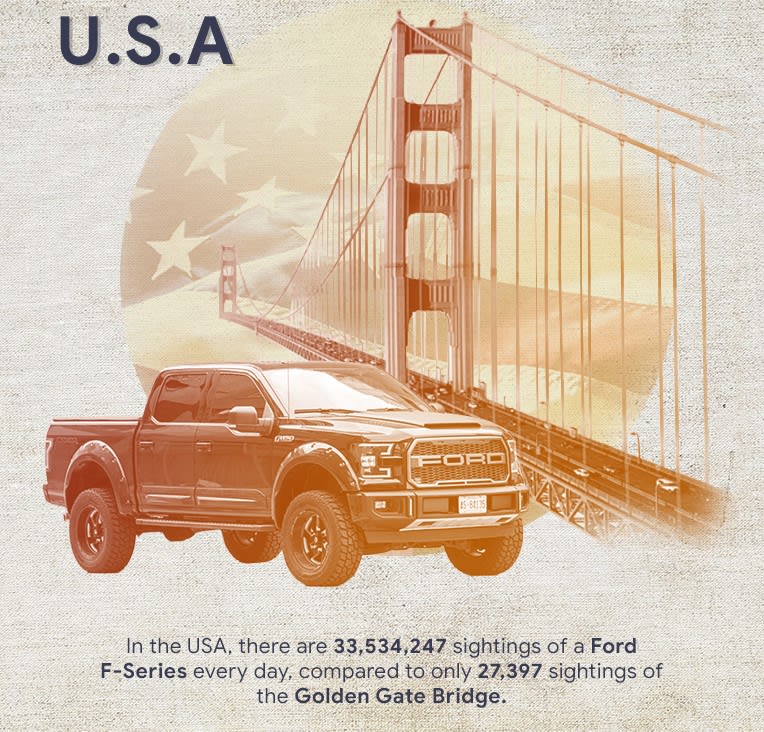
The Ford F-Series is an American instuition and has been the best-selling vehicle in the US for almost 37 consecutive years. Highly recognisable in its various guises, the F-Series is about as American as NASCAR, country music and the hamburger. The F-Series is a giant in the US and we estimate its daily sightings at more than 33m every day. One of America's most famous landmarks and a vital connection between San Fransisco Bay and the Pacific Ocean is only seen a meagre 27,397 every day, comparatively small fry compared to the F-series.
Renault Clio v Mona Lisa
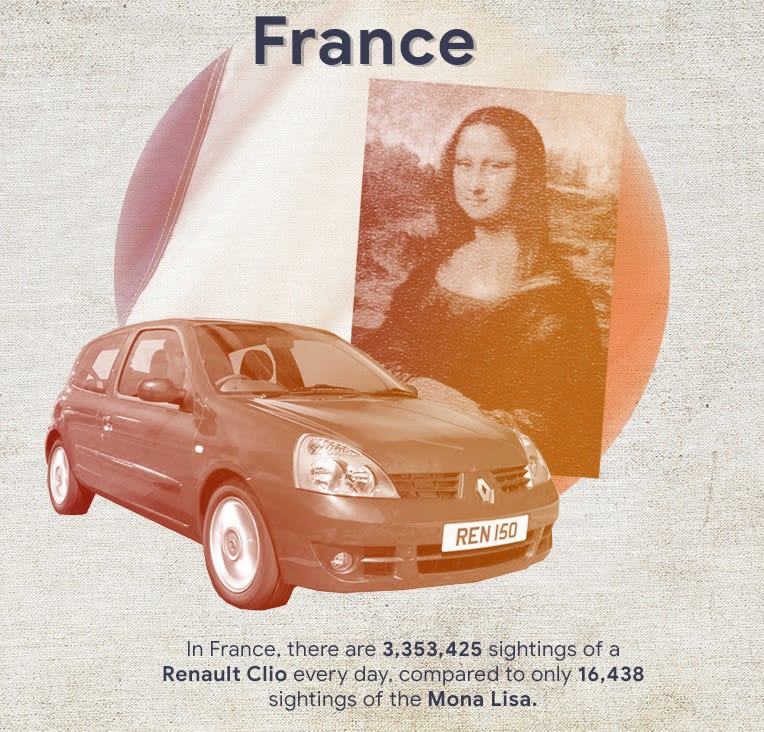
The Renault Clio is a treasured darling of Europe, especially France, where it's held the crown of the nations favourite car for the last six years.The popularity of the Clio has stretched far and wide, with it's agile frame and efficient engines making it a huge hit across the continent. What better work of art to pit an icon of modern Europe against, other than the Mona Lisa? Da Vinci's masterpiece and arguably the most famous painting of all time, the Mona Lisa attracts visitors and acclaim from all over the globe. But it doesn't quite get the daily coverage of a Clio - with only 16,438 sightings of the Mona Lisa every day, there are 3.3m people feasting their eyes on a Clio on a daily basis.
Fiat Uno v Sistine Chapel
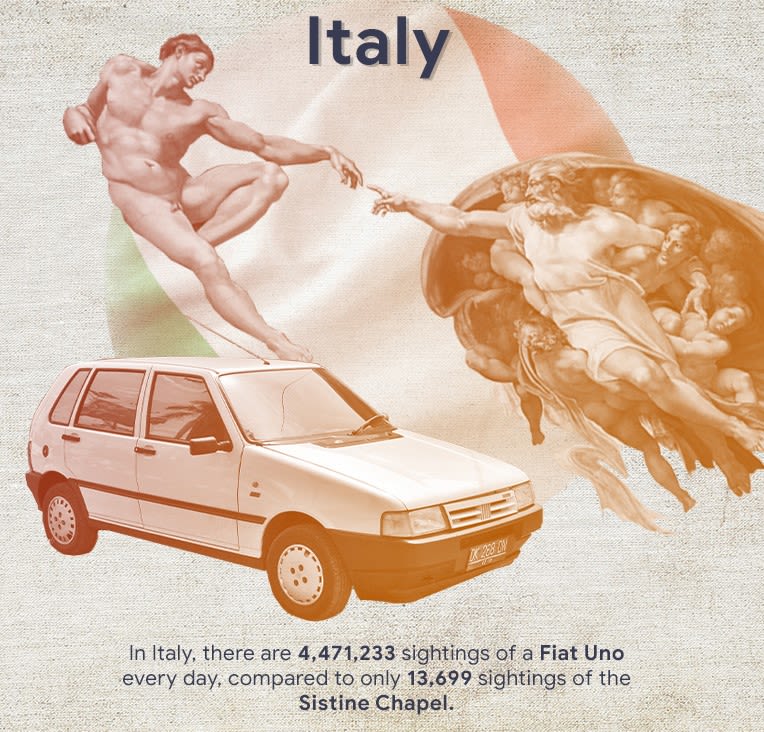
When Giurgetto Giugiaro designed the Uno, he could scarcely have predicted the sheer magnitude of this dainty hatchback's success. Hot property thanks to it's unique design and cheap running costs, the Uno has now become an icon across modern day Europe.
Much like the Uno, The Sistine Chapel forms a vital part of Italian culture. Michelangelo's masterpiece was built and completed in the 15th century and attracts more than 13,000 visitors every day for it's awe-inspiring beauty. But the Uno blows the figures out of the water with relative ease, with over 4.4m sightings every single day. Fiat even halted production of the Uno in 1994, so maybe the Sistine Chapel will catch up eventually?
Ford Falcon v Sydney Opera House
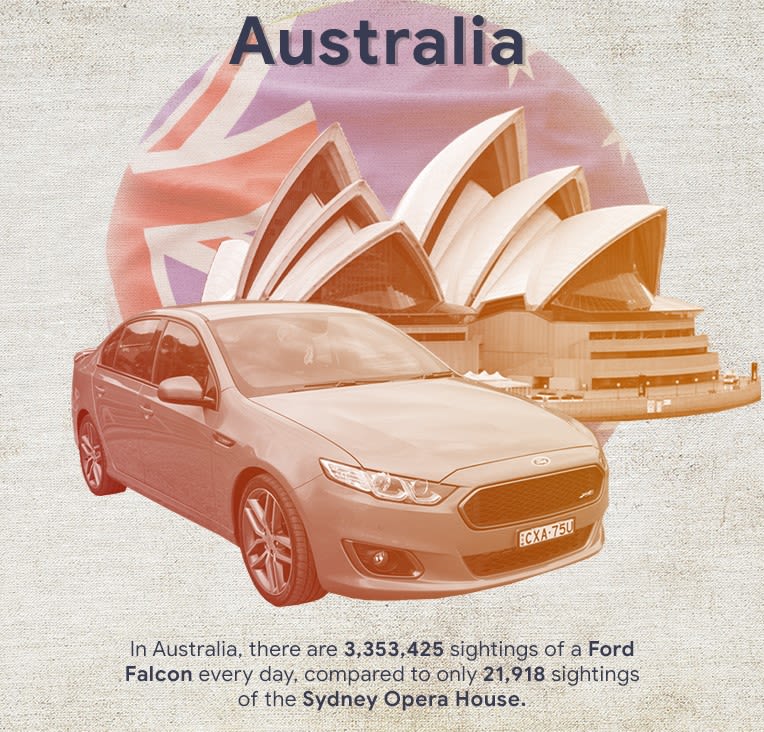
The Ford Falcon is a cherished part of Australian culture and society. In what can only be described as a disastrasouly unpopular move, the Falcon's production was halted in 2016, making way for the globally recognised Mondeo. Three years later the Falcon is still the country's best selling car of all time, despite a new model not rolling off the production line in that time. In Australia you can't travel far without seeing a Falcon, which commands over 3.3m sightings every day in comparison to the distinctive and iconic Syndey Opera House which was opened in the 70s, but still only draws just shy of 22,000 sightings daily.
Seat Ibiza v Sagrada Familia
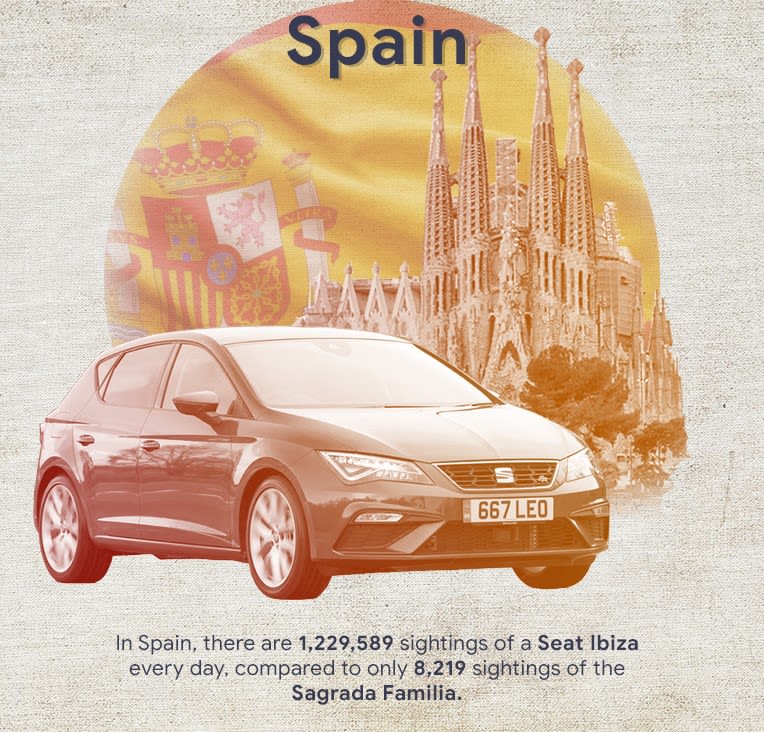
Named after the famous mediterrenean island, the Ibiza is ubiquitious in Spain where Seat's reputation is held in high regard. There a few manufacturers who have grown so rapidly other than Seat, which has doubled the number of models in the range in the last few years and also successfully branched out into the crossover and SUV market. The Sagrada Familia is one of Europe's most impressive feats of Gothic Architecture and is ingrained in the life and economy of it's home city, Barcelona. But as a work of art, it's not a patch on the Ibiza for it's sightings with Seat's chief hatchback garnering almost 150 times more sightings every day.
Toyota Corolla v Himeji Castle
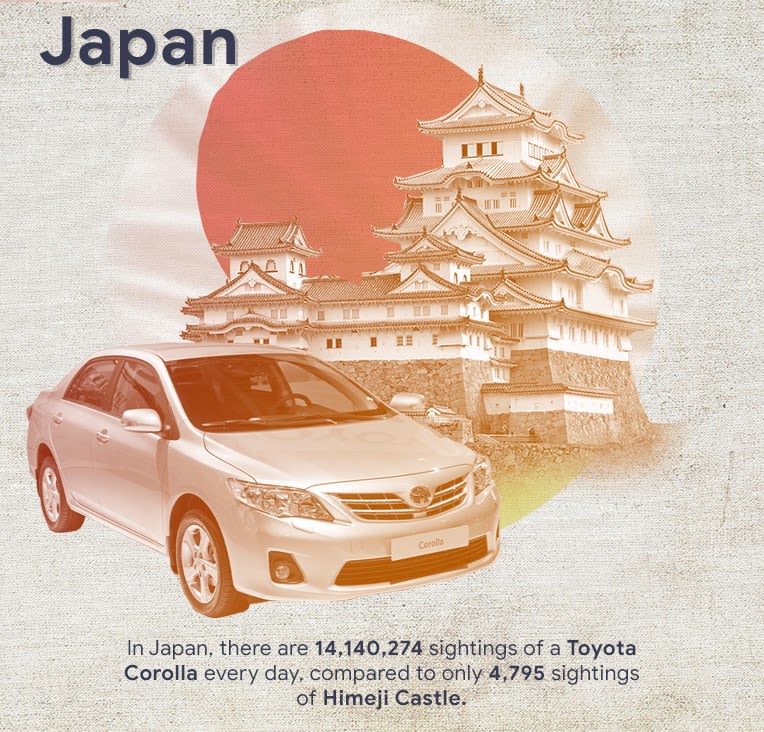
The Corolla's reputation and impact cannot be underestimated. It is the world'd best selling car by some distance, with 40million new units shifted as of 2013. With a new model introduced earlier in 2019, it seems unlikely the Corolla's dominance is coming to an end any time soon. Because the Corolla is so popular, its spotted over 14m times a day in Japan and you can be sure it's instantly recognisable to each and every one of those people. Such is the gargantuan success of the Corolla, it's almost unfair to compare it to any other of Japan's famous artworks, of which several stand out as truly stunning. The Himeji Castle's outstanding beauty and historical significance makes it one of the world's most incredible sights, but it finds itself far eclipsed by the Corolla in our estimated viewings.
Ford Fiesta v Angel Of The North
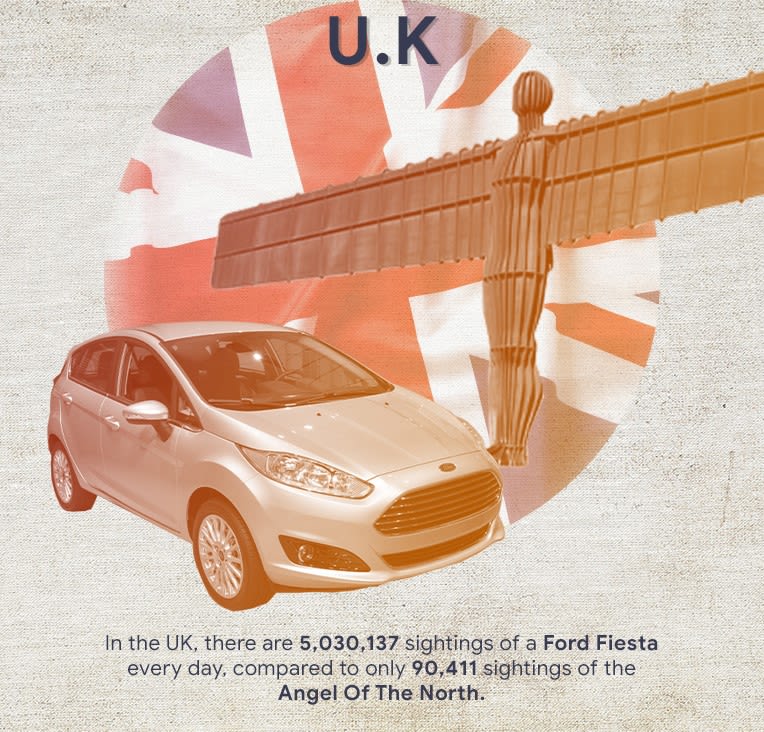
The Fiesta has been one of the UK's most successful cars since it rolled onto these shores in the mid 70s. It's been the best selling car in the UK for several years and is embroiled in a fierce battle for top spot with it's small hatch rival - the Vauxhall Corsa. The Angel of the North was finished twenty years after the Fiesta and has become one of the UKs most adored landmarks. It's 90,000 daily sightings are impressive, but nowhere near the Fiesta's massive 5 million.
VW Golf v Cologne Cathedral
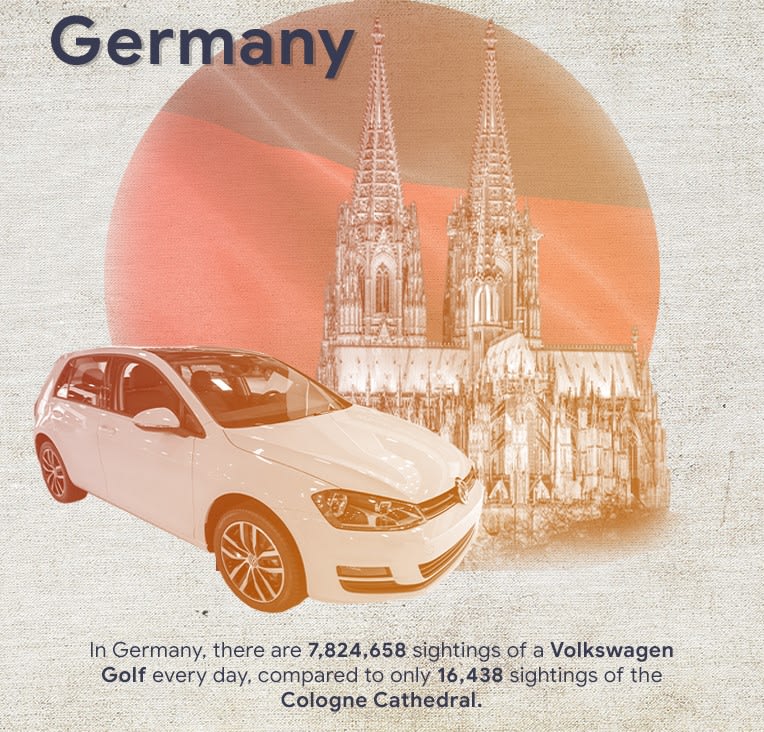
Europe's favourite car of all time, the VW Golf is no stranger to tough competition. After all, it's been fighting off competition to retain top spot for family hatchback for a number of years. In the Cologne Cathedral, it faces one Germany's most striking pieces of architecuture and a recognised World Heritage (WHO) site. The Golf completes the set of victorous cars against traditional forms of artistry and does so in quite some style. There are over 7m sightings of the Golf in Germany, making it the clear winner.
3. The Designers Who Will Shape the Future
In previous years, automotive designers traditionally hailed from nations with the biggest concentration of brands such as Germany, Italy, America and the UK.
However, things are changing. Brands are now hiring a more diverse group of designers from all over the globe, who are in turn influencing the look and feel of the motoring world. Designers such as Chris Bangle who was BMW Group’s first American Chief of Design drove change and innovation at BMW throughout the ’90s.
Our global 'designer location' map below shows the top 50 motoring brands in the world and where their current lead designers originate from, simply highlighting how geo-diverse designers are in 2019:
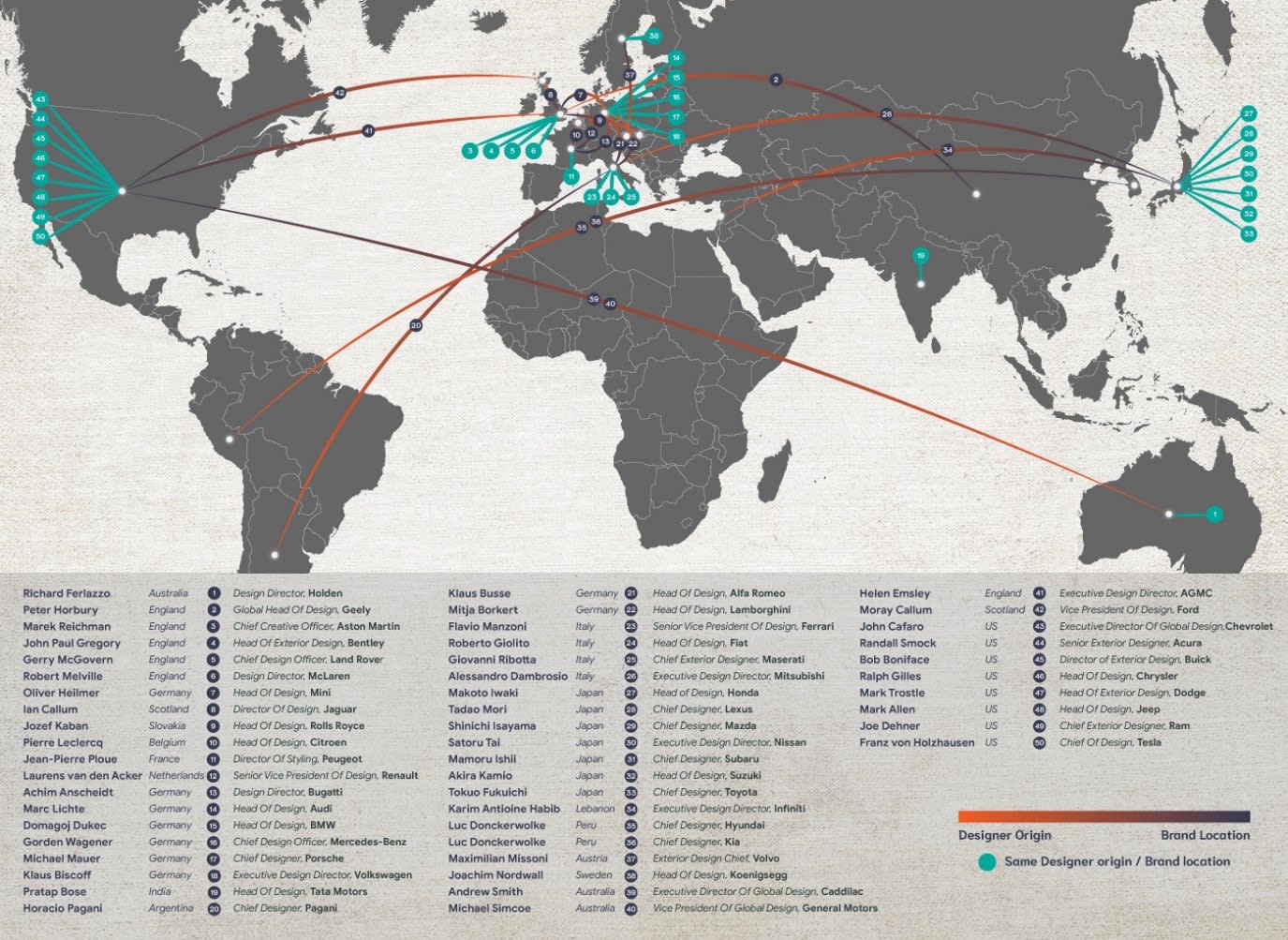
As the responsibility for motoring innovation is passed on to the next generation as we move into an age of self-driving and electric cars, the capacity for automotive designers to innovate will be tested. This is also threatened by the trend of technology companies planning to introduce competitors into these markets that the traditional brands once had a monopoly over. But, no matter how the world of motoring will look in the decades to come, we can look forward to some future classic designs that will continue shape and influence our lives across the globe.

















